Articles and Features
Top 10 ‘Readymade’ artworks

The readymade has been a feature of modern art since the early part of the twentieth century. The first found object repurposed for inclusion in a work of art can be traced to Picasso’s cubist collage of 1912, Still Life with Chair Caning, when he pasted a magazine image of chair caning onto the artwork to represent the seated surface in the picture. The concept of the readymade is generally considered to have been perfected by Marcel Duchamp, whose dada irreverence commenced with Bicycle Wheel of 1913, and continued through the decade with other objects presented as sculptural art forms. In fact it was Duchamp who coined the phrase readymade, two years after the bicycle wheel work and after making further works conforming to the concept, such as Bottlerack, and even a snow shovel, poetically titled In advance of the broken arm. Prior to that the term ‘found object’ was employed, derived from the French objet trouvé, utilised to describe art that was created from undisguised, sometimes modified, objects or products that have another practical function and not normally considered materials from which art is made. During the past hundred years in which the readymade has become a staple material of art production it has been employed in many different ways by countless artists, but most often never losing its ability to shock or surprise. We take a look at 10 seminal examples.
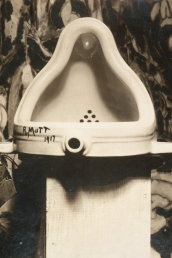
photograph by Alfred Stieglitz at 291,
Society of Independent Artists exhibition.
1. Marcel Duchamp, Fountain, 1917
After Duchamp arrived in the United States in 1915, he became involved with Picabia and Man Ray, amongst others, in the formation of a dadaist anti-rational, anti-art cultural movement. Fountain consists of an ordinary porcelain urinal signed “R.Mutt”, after the Mott manufacturers of toilets, and from whose catalogue Duchamp claimed to source the piece. It was submitted by him for the inaugural exhibition of the Society of Independent Artists exhibition at the Grand Central Palace in New York, an organisation of which he was a board member.
In the presentation the usual orientation was altered as seen in the image. It caused such a furore that it was ommitted from the main show area, but its legend became firmly established by the images Steglitz took of the work in his studio, and through sixteen replicas made in the 50s and 60s with Duchamp’s approval. The original was lost, but became the iconic and widely acknowledged debut of the readymade at the very centre of contemporary art production.

2. Pablo Picasso, Tete de Taureau (Bull's Head), 1942.
In 1944, catalogued as Bicycle Seat, the sculpture was displayed at the Salon d’Automne in Paris together with another 78 works. Visitors were shocked by Picasso’s new works and a demonstration took place, during which Bicycle Seat was one of the pieces removed from the exhibition. Notable for its incredible and inspired simplicity, it is also an example where the found object stands in as a visual representation of another thing that it resembles. When discussing the artwork with George Brassaï in 1943, Picasso explained that: “One day, in a pile of objects all jumbled up together, I found an old bicycle seat right next to a rusty set of handlebars. In a flash, they joined together in my head. The idea of the Bull’s Head came to me before I had a chance to think. All I did was weld them together…”. Now widely regarded as one of Picasso’s most renowned works it was described by Roland Penrose, the eminent Surrealist scholar, as a “simple yet astonishingly complete metamorphosis”.

3. Robert Rauschenberg, Canyon, 1959
Canyon is one of Rauschenberg’s so-called ‘combines’, a group hybrid works incorporating painting, collage, and found objects that he began making in 1954. Rauschenberg often kept an eye out for curious items in the street while walking around downtown New York, later repurposing “whatever the day would lay out” for his artistic ends. The centerpiece of Canyon is a stuffed bald eagle that was found in a pile of discarded belongings in the hallway of the Carnegie Hall studio building and given to Rauschenberg by fellow artist Sari Dienes. It juts out from a canvas covered with pieces of a collared shirt, floral fabric, a photograph of Rauschenberg’s young son, a flattened metal drum, and a wrung–out tube of oil paint, among many other items.
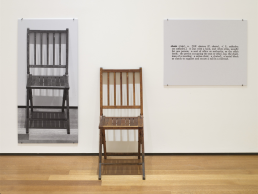
4. Joseph Kosuth, One and Three Chairs, 1965
Does the inclusion of an object in an artwork somehow change it? As Duchamp asked 50 years earlier with his readymade sculptures, so does Kosuth’s seminal masterpiece, but in a subtly different way. The piece consists of a chair, a photograph of the chair, and an enlarged dictionary definition of the word “chair”. The photograph depicts the chair as it is actually installed in the room, and thus the work changes each time it is installed in a new venue. Two elements of the work remain constant: a copy of a dictionary definition of the word “chair” and a diagram with instructions for installation. Both bear Kosuth’s signature. If both photograph and words describe a chair, how is their functioning different from that of the real chair, and what is Kosuth’s artwork doing by adding these functions together? Prodded to ask such ontological and semantic questions, the viewer embarks on the basic processes demanded by one of the key pieces of early conceptual art—the piece can be seen to highlight the relations, differences and problems between language, picture and object.
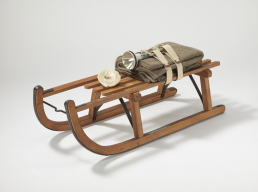
5. Joseph Beuys, The Sled, 1969
A ball of lard, a pile of felt and a torch attached to a sled. Beuys’s 1969 sculpture is a proxy for a primitive rescue vehicle. Apparently such a survival kit was used by the Tatars to rescue Beuys after his Stuka plane was shot down in 1943. The simple sled—one of the first transports used by man—is loaded with a torch for orientation, lard for sustenance, and finally felt for warmth, Beuys called these his “survivor materials”. Beuys was a master at propagating legends and the one that became central to his work surrounded his activities in World War II. His work transcended artistic genres defying specific categorisation, challenging the artist as shaman to produce works that are both powerful and personal encompassing a world of myth, ideas, obsessions and hope. His prolific oeuvre spanned decades, ranging from painting to performances, but it is perhaps his sculptural installations that provide the clearest manifestations of his unique brand of art making.

New Shelton 5 Gallon Wet/Dry, New Shelton 10 Gallon
Wet/Dry Doubledecker, 1981-1986.
6. Jeff Koons, The New Series, 1979-86
From around 1979 Koons worked primarily on a series called The New, a series of vacuum cleaners, often selected for brand names that appealed to the artist like the iconic Hoover which he had mounted in illuminated plexiglass boxes.
Koons first exhibited these pieces in the window of the New Museum in New York in 1980. He chose a limited combination of vacuum cleaners and arranged them in cabinets accordingly, juxtaposing the verticality of the upright cleaners with the squat cylinders of the “Shelton Wet/Dry drum” cleaners.
At the museum, the machines were displayed as if in a showroom, and oriented around a central red fluorescent lightbox with just the words “The New” written on it as if it were announcing some new concept or marketing brand.

7. Felix Gonzalez-Torres, Untitled (USA Today) 1990
In 1990 Gonzalez-Torres began a series of works consisting of arrangements of wrapped candies, arranged poured into a corner, or in a display carpeting a rectangular area of the floor. The idea was that each would consist of an endless supply. In this example candies are individually wrapped in red, silver, and blue cellophane. In total, Gonzalez-Torres created nineteen candy pieces which were featured in many museums around the world, some of which are considered portraits of the person the work is named for. Many of his installations invite the viewer to take a piece of the work with them: this series allows viewers to take packaged candies from a pile in the corner of an exhibition space and, in so doing, contribute to the slow disappearance of the sculpture over the course of the exhibition. The most pervasive reading of González-Torres’ work takes the processes his works undergo as metaphor for the process of dying (disappearing pile of candy). However, many have seen the works also representing the continuation of life with the possibility of regeneration (replenishment of candy and re-installation). Gonzalez-Torres died of AIDS related illness in 1996, and it has been argued that the works portray the dissolution of the gay community as a result of the AIDS/HIV epidemic. As a person eats the candy and throws the wrapper away, the pile decreases in size, representing how society ignored the existence of this epidemic, which then led to deaths of many gay people.
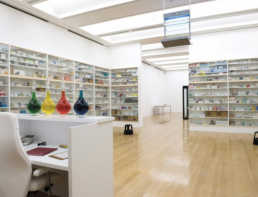
8. Damien Hirst, Pharmacy, 1992
Many of Hirst’s works are memorable for their provocative materials, involving flies, dead animals and formaldehyde. Through these works Hirst makes uncompromising statements about the transience of life.
In this room installation, replicating a pharmacy, he recreates the clinical atmosphere one expects from such a premises. He views medicine as a powerful belief system: we are seduced by drugs, believing they will cure all ills and preserve life, though rarely questioning their side-effects. It was conceived as a site-specific installation and initially shown at the Cohen Gallery, New York, in 1992. Hirst had been making glass-fronted cabinets of the type found in a laboratory or hospital, stacked with pharmaceutical drugs as well as other objects, since 1989. In these works (but not in the case of Pharmacy) he arranged the drugs on the shelves so that they implied a model of the body: those at the top are medicines for the head; in the middle medications for the stomach; and those at the bottom to treat ailments of the feet. These works are related to his famous ‘spot’ paintings, which bear the names of pharmaceuticals as their titles. In Hirst’s Pharmacy the small medicine cabinets of the earlier pieces have been expanded to cover the walls with rows of packaged drugs behind glass. Four glass apothecary bottles filled with coloured liquids stand in a row on a counter and represent the four elements: earth, air, fire, water. At the centre is an
insect-o-cutor, an electrical element that lures flies to a brutal death.
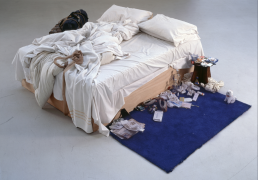
9. Tracy Emin, My Bed, 1998
The idea for My Bed was inspired by a depressive phase in the artist’s life when she had remained in bed for several days without eating or drinking anything but alcohol. Having recently broken up a relationship she remained ensconced in her room, in both a disconsolate state and stupor. When she looked at the repulsive state she had left and the vile mess that had accumulated in her room, she suddenly realised what she had created. The artwork generated considerable controversy, with the ensuing media furore focusing on the bedsheets stained with bodily secretions and the floor being strewn with items from the artist’s room, such as condoms, underwear with menstrual blood stains, other detritus, and functional, everyday objects, including a pair of slippers. The bed was presented exactly in the state that Emin claimed it had been after languishing in it for several days was over.
My Bed was exhibited at the Tate Gallery in 1999 as one of the shortlisted works for the Turner Prize. Although it did not win the prize, losing out to Steve McQueen, its notoriety has persisted.
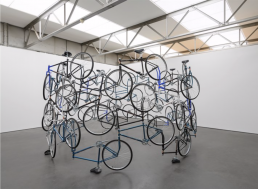
10. Ai Weiwei, Forever, 2003
In the work Forever both the title and form of the piece suggest the notion of eternity. Ai arranges Forever-brand bicycles in a closed circular column. Since the company’s establishment in China in 1940, these bicycles have become the most iconic and widely sold brand of bicycle. The use of the bicycle as an object of art recalls Duchamp’s original Readymade Bicycle Wheel (1913), reflecting Ai’s fascination with this artist. It is also a common tactic of the artist to retain the essential structure of a readymade element in his work, whilst at the same time reconstituting or reformulating it into an entirely new form. Here the external form of the bicycle is retained, formerly China’s most widespread mode of transportation, while eliminating its function, just as the bicycles’s raison d’etre is being made obsolete by the automobile in Chinese society— the bicycles can go nowhere since their handlebars and pedals have been removed. The monumental sculpture of bicycles interlinked in a circle elicits questions of harmony, eternity and equality in a rapidly changing society.